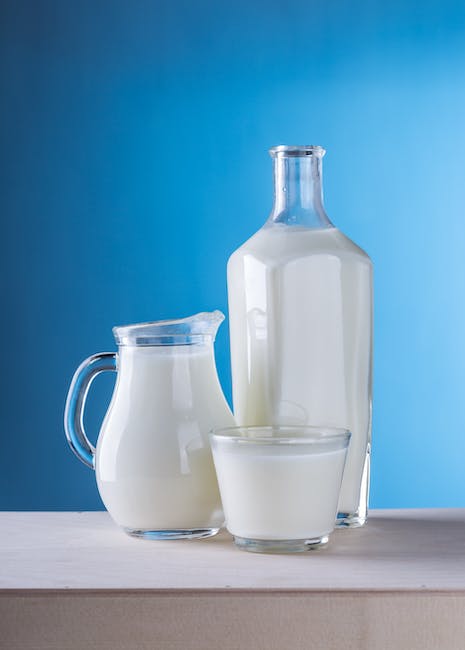How To Cut Out Dairy While Breastfeeding
Being a new mom is a beautiful experience, but it can also come with its fair share of challenges if you have discovered that your baby is sensitive to dairy and need to eliminate it from your diet while breastfeeding, you may feel overwhelmed.
However, cutting out dairy doesn’t have to be a daunting task. With some guidance and planning, you can ensure that you and your baby are healthy and thriving. This article will provide some tips and advice on successfully cutting out dairy while breastfeeding.
Why Cut Out Dairy?
Before we dive into the practical tips, let’s briefly discuss why cutting out dairy might be necessary. Some babies are born with a sensitivity or allergy to cow’s milk protein, which can be passed on through breast milk. Common symptoms in babies include colic, eczema, gas, or fussiness after feedings.
Removing dairy from your diet can help alleviate these symptoms and improve your baby’s overall well-being.
Tips for Cutting Out Dairy
1. Educate Yourself
Start by familiarizing yourself with the various names and hidden sources of dairy. Besides prominent dairy products like milk, cheese, and yogurt, dairy can also be present in processed foods, baked goods, and some medications. Read labels carefully and look for whey, casein, lactose, and butterfat ingredients.
2. Seek Support
Reach out to other breastfeeding moms who have gone through a similar journey or join online support groups. Having a support system can be immensely helpful when facing dietary changes. During this transition, they can provide advice, share recipes, and offer emotional Support.
3. Find Alternatives
Fortunately, a variety of dairy alternatives are available today, making it easier than ever to maintain a nutritious diet. Explore options like almond milk, coconut milk, or soy milk. Experiment with dairy-free recipes and incorporate foods rich in calcium and vitamin D to ensure you’re still meeting your nutritional needs.
4. Keep a Food Diary
Tracking your meals can help you identify any hidden sources of dairy that might have slipped into your diet. You can make connections and adjust your diet by noting down what you eat and any symptoms your baby experiences.
5. Consult a Healthcare Professional
If you’re unsure about cutting out dairy or have concerns about your baby’s health. They can provide personalized advice based on your situation and ensure you’re making the right choices for you and your baby.
What are the potential risks and benefits of cutting out dairy while breastfeeding?
I am cutting out dairy while breastfeeding can have potential risks and benefits.
Potential risks of cutting out dairy while breastfeeding include:
1. Nutritional deficiencies: Dairy products are a significant source of calcium, vitamin D, and other essential nutrients. Cutting them out without finding suitable replacements may lead to nutrient deficiencies, harming both the mother and the baby.
2. Limited food choices: Eliminating dairy products from the diet can limit the variety of foods available to the mother. This can make meal planning and eating out more challenging.
3. Increased stress and restricted diet: Cutting out dairy can be problematic and may require reading labels and avoiding certain foods. This can increase stress and make it harder for the mother to follow a balanced and healthy diet.
On the other hand, potential benefits of cutting out dairy while breastfeeding include:
1. Resolving infant symptoms: Some breastfed babies may develop colic, gas, congestion, or skin issues due to an intolerance to dairy proteins. Cutting out dairy may help alleviate these symptoms in some cases.
2. Improved digestion: If the mother or baby has lactose intolerance or a sensitivity to dairy, eliminating dairy products can improve digestion and reduce discomfort.
3. Preventing allergic reactions: If there is a family history of dairy allergies, cutting out dairy while breastfeeding may help reduce the risk of the baby developing an allergy.
It is essential to discuss any dietary changes with a healthcare provider or a registered dietitian to ensure that both the mother and the baby receive adequate nutrition while breastfeeding.
Are there alternative sources of calcium and other essential nutrients that breastfeeding mothers should consider if they choose to eliminate dairy?
Yes, there are alternative sources of calcium and other essential nutrients that breastfeeding mothers can consider if they choose to eliminate dairy from their diet. Some of these alternative sources include:
1. Leafy green vegetables: Vegetables like kale, broccoli, spinach, and bok choy are excellent sources of calcium. They can be incorporated into various dishes, salads, or smoothies.
2. Fortified plant-based milk: Plant-based milk alternatives like almond milk, soy milk, and oat milk are often fortified with calcium and other essential nutrients. These can be used as a substitute for dairy milk.
3. Legumes and beans: Legumes such as chickpeas, lentils, and black beans are rich in calcium and provide other essential nutrients like iron and protein.
4. Nuts and seeds: Almonds, sesame seeds, and chia seeds are good sources of calcium and can be added to meals or snacks.
5. Tofu and tempeh: These soy-based products are high in calcium and provide protein, making them a nutritious alternative to dairy products.
6. Calcium-fortified foods: Cereals, bread, and orange juice are fortified with calcium. Checking food labels for calcium fortification can help in finding suitable alternatives.
It is essential for breastfeeding mothers who choose to eliminate dairy to ensure they are getting enough calcium and other essential nutrients from these alternative sources. Consulting with a healthcare professional or a registered dietitian can help create a balanced and nutrient-rich diet plan.
Conclusion
Eliminating dairy from your diet while breastfeeding can seem challenging at first, but it is doable with the proper knowledge and Support. Every mom and baby is different, so finding what works best for you may require trial and error. Stay patient, and remember the positive impact this change can have on your baby’s health. You’re doing an incredible job as a mom!


